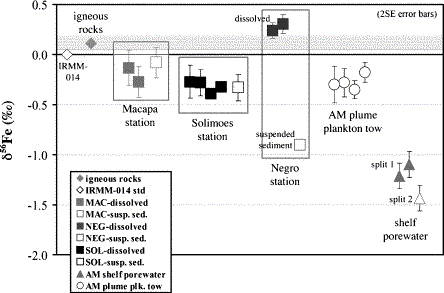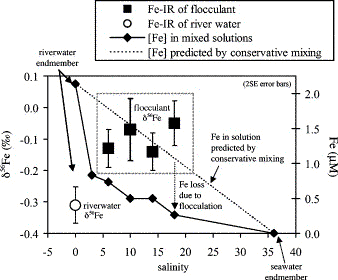
『Abstract
Trace metal clean plankton tows, river samples, aerosol leachates,
and porewater samples from the Amazon River system were measured
for their iron isotopic composition. The overall isotopic range
observed was 1.5‰ with Fe isotopic variability observed between
different types of tributaries. Dissolved Fe and suspended load
Fe from two main channel sites were isotopically similar (≒-0.1
to -0.3‰). In contrast, the dissolved Fe and suspended load Fe
from an organic rich tributary, the Negro River, were isotopically
distinct with the dissolved slightly isotopically heavy (+0.3‰)
and the suspended load isotopically light (-0.9‰). The isotopically
lightest sample from the Amazon region was shelf porewater (-1.3‰).
In river water-seawater mixing experiments, the Fe isotopic signal
of dissolved Fe of river water was modified by flocculation of
isotopically heavy Fe. The variability of the Fe isotopic composition
of natural samples including biological and aqueous samples demonstrates
that significant fractionation is associated with Fe biogeochemistry
in the environment.
Keywords: iron isotopes; weathering; rivers; iron; plankton tows;
porewaters; river water-seawater mixing experiments』
1. Introduction
1.1. Iron isotopes
1.2. River dissolved Fe
2. Sites, sample collection, and methods
2.1. River dissolved Fe and suspended sediment
2.2. River water-seawater mixing experiments
2.3. Amazon shelf porewater
2.4. Amazon plume plankton tow
2.5. Fe concentration measurements
2.6. Fe purification and isotopic analysis
3. Results and discussion
3.1. River dissolved Fe and suspended sediment
3.2. River water-seawater mixing experiments
3.3. Amazon shelf porewater
3.4. Amazon plume plankton tow
4. Conclusions
Acknowledgements
References

 Fig. 3. Summary of Fe isotopic data for samples from the Amazon region. The granite (USGS, G-2) and basalt (BVHO-1) splits along with the IRMM-014 standard are shown for reference. The dissolved Fe (■, <0.4μm filtered) and suspended sediment (□) are plotted for the three river sample sites. Also shown are the Amazon plume plankton tow and shelf porewater sample. The replicate points for samples represent the δ56Fe for a sample or a sub-sample that was processed separately through the entire Fe separation and purification chemistry. Error bars are the 2SE of replicate measurements. Data can be found in Table 2 and Table 3. 〔Bergquist,B.A. and Boyle,E.A.(2006): Iron isotopes in the Amazon River system: Weathering and transport signatures. Earth and Planetary Science Letters, 248, 39-53.から〕 |
 Fig. 4. River water-seawater mixing experiment. The Fe (◆) concentration of the river water-seawater solutions after the flocculent was removed by filtration is shown with the solid line. The dashed line is the Fe concentration predicted if the river water and seawater were to mix conservatively. The Fe loss due to colloidal coagulation and flocculation is represented by the difference between the two lines. The river water δ56Fe (○) was -0.31±0.06‰ (2SE, n = 13). Specifically the sample of river water used for this experiment was Solimoes(後のoの頭に〜) River sample 3, which had slightly higher dissolved Fe (2.1μM) compared with the other samples (< 1μM). The flocculent δ56Fe (■) in this experiment was isotopically heavier than the river water Fe from which it was derived. This implies that the remaining dissolved Fe must be isotopically light compared to the river water endmember. Error bars are the 2SE of replicate measurements. 〔Bergquist,B.A. and Boyle,E.A.(2006): Iron isotopes in the Amazon River system: Weathering and transport signatures. Earth and Planetary Science Letters, 248, 39-53.から〕 |